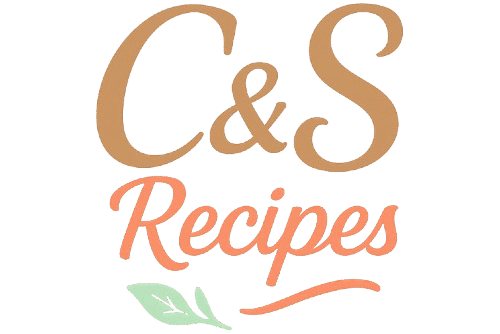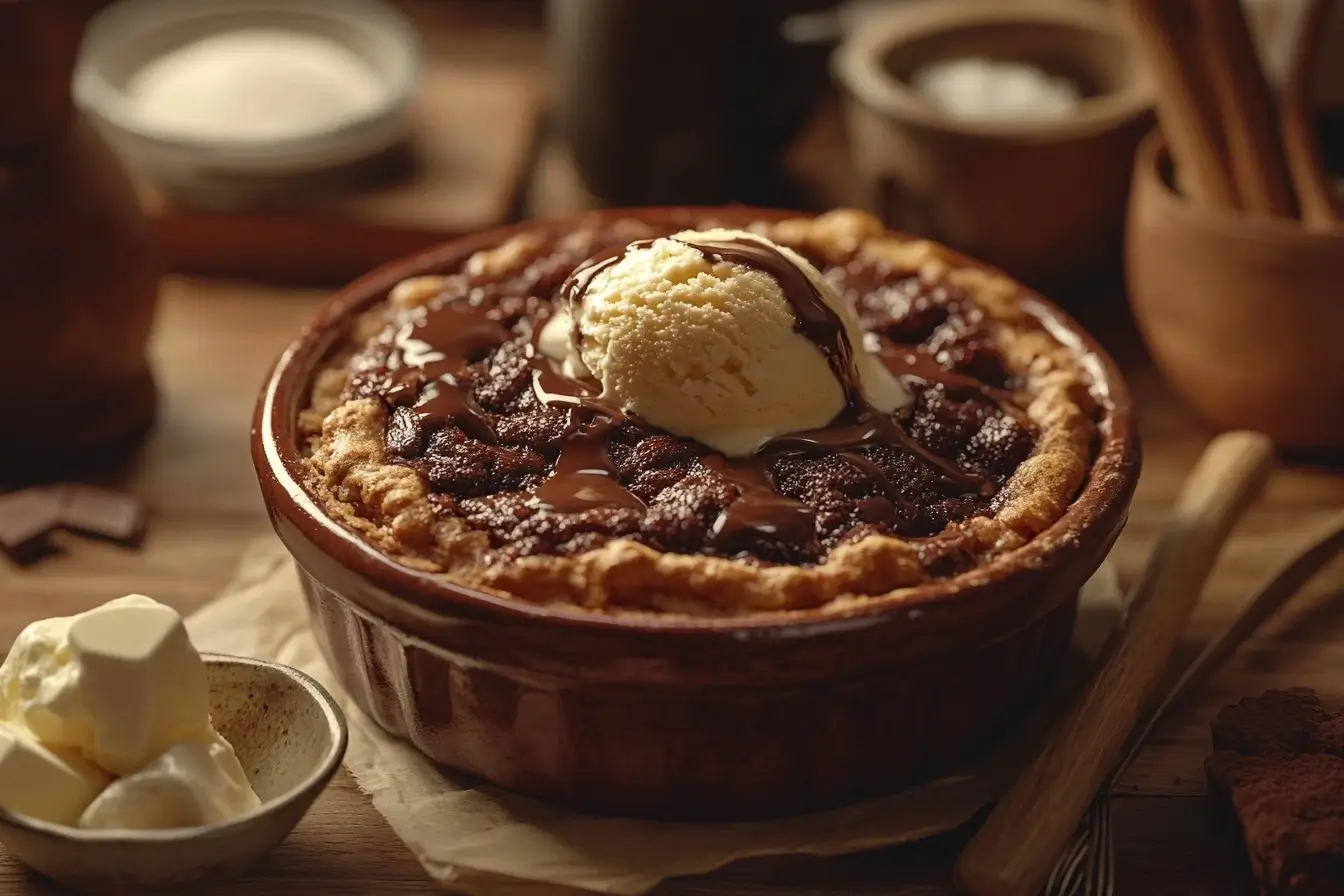Creating a chocolate cobbler at home is both simple and rewarding. This comforting dessert combines a rich, gooey chocolate base with a delightful, cake-like topping. Whether you’re a seasoned baker or just starting, this guide will walk you through the process, providing tips, variations, and answers to your most pressing questions. Get ready to impress family and friends with a dessert they’ll rave about!
Understanding Chocolate Cobbler
Definition and Origins
A chocolate cobbler is a delightful dessert that merges simplicity with decadence. It consists of a chocolate batter layered with sugar and cocoa, then topped with boiling water. As it bakes, the water sinks to the bottom, creating a rich, pudding-like sauce beneath a soft, cakey top. This dessert is part of a larger family of cobblers, which traditionally include fruits or savory fillings topped with a biscuit or cake-like crust.
Cobblers have their roots in early American cooking, where settlers adapted their pie recipes to the limited ingredients and equipment they had on hand. Over time, variations like chocolate cobbler emerged, bringing a new twist to this time-honored dish. Today, it’s a Southern classic beloved across the United States.
Popularity in Modern Cuisine
In modern kitchens, chocolate cobbler enjoys widespread acclaim for its ease of preparation and indulgent taste. It’s a go-to recipe for busy home cooks who want something warm and satisfying without spending hours in the kitchen. The combination of nostalgic comfort and rich flavors has made it a staple at potlucks, family gatherings, and even casual weeknight dinners. For more detailed tips, recipes, and frequently asked questions, check out this guide on How to Make the Perfect Chocolate Cobbler.
Differentiating Cobblers from Other Desserts
Cobblers vs. Pies
While cobblers and pies both hold a place in the hearts of dessert lovers, their structures and preparation methods set them apart. A pie relies on a flaky crust to encase its filling, often requiring careful rolling and precise handling. In contrast, a cobbler skips the bottom crust altogether, instead highlighting a biscuit-like topping that beautifully complements the filling beneath. This difference makes cobblers more rustic and easier to prepare than their pie counterparts.
Cobblers vs. Crumbles and Crisps
Cobblers differ significantly from crumbles and crisps, thanks to their unique toppings. Crumbles and crisps are known for their streusel-like mixtures of butter, sugar, and oats, which create a crunchy layer over the filling. Meanwhile, cobblers feature a batter or dough topping that bakes into a soft, cake-like layer. This contrast is particularly evident in chocolate cobbler, where the tender topping merges harmoniously with the gooey chocolate sauce below.
Essential Ingredients for Chocolate Cobbler
Dry Ingredients
Flour Types
Flour is the backbone of any cobbler batter, and all-purpose flour is typically the go-to choice for chocolate cobbler. It provides the right balance of structure and softness. For a gluten-free alternative, you can use a 1-to-1 gluten-free baking mix, which works just as well without altering the flavor.
Cocoa Powder Varieties
The cocoa powder is the star of the show, lending a deep, rich chocolate flavor. Natural cocoa powder provides a slightly tangy, intense taste, while Dutch-processed cocoa powder offers a smoother, milder flavor. Whichever you choose, make sure it’s unsweetened to maintain control over the recipe’s sweetness.
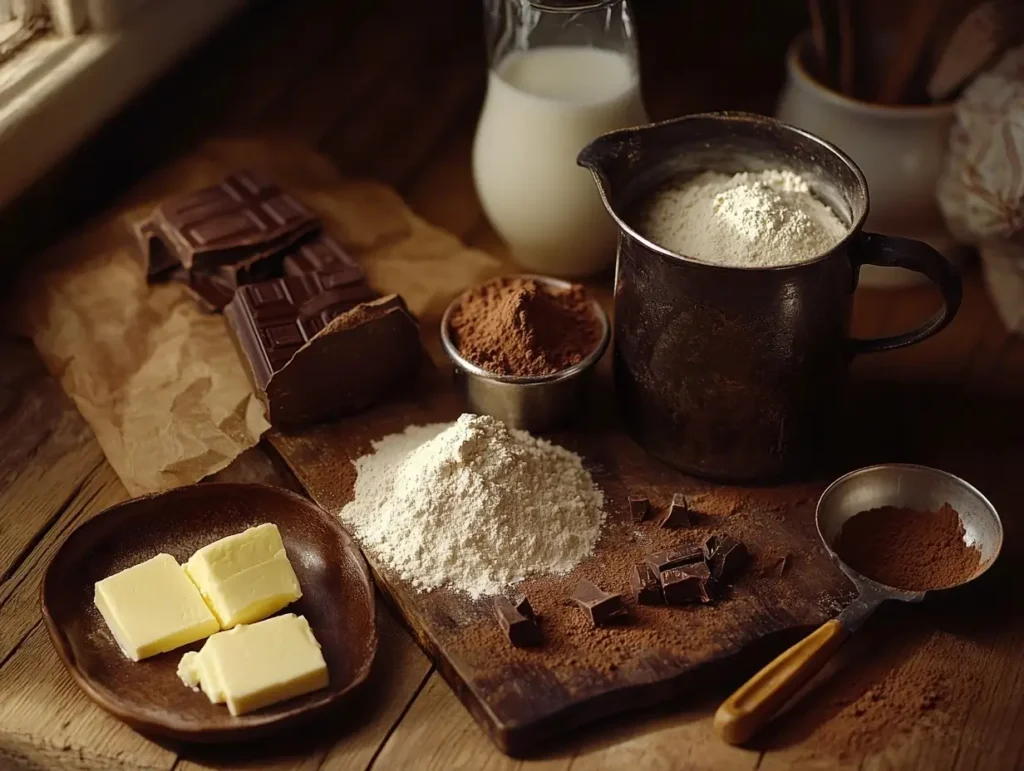
Wet Ingredients
Milk Options
Milk adds moisture and binds the batter together. Regular whole milk is commonly used, but you can substitute it with plant-based options like almond or oat milk for a dairy-free version. Each brings its own subtle flavor, so choose based on your preferences.
Butter vs. Margarine
Butter contributes a rich, creamy flavor that elevates the dessert’s texture. Margarine, on the other hand, is a budget-friendly alternative and works in a pinch. For the best results, stick with unsalted butter to avoid altering the balance of flavors.
Sweeteners
Granulated Sugar
Granulated sugar provides the classic sweetness and helps create the gooey sauce at the bottom of the cobbler. It also caramelizes during baking, enhancing the overall depth of flavor.
Brown Sugar
Brown sugar adds a touch of molasses, deepening the dessert’s richness. Combining both granulated and brown sugar creates a well-rounded sweetness and improves the texture of the sauce.
Recommended Equipment
Baking Dish Selection
Choose a medium-sized, oven-safe baking dish, such as an 8×8-inch glass or ceramic dish. These materials ensure even heat distribution, resulting in a perfectly baked chocolate cobbler.
Mixing Tools
You’ll need a mixing bowl and a whisk or wooden spoon to combine your ingredients efficiently. Silicone spatulas are also handy for scraping batter from the bowl.
Measuring Instruments
Accurate measurements are crucial in baking. Use a set of measuring cups and spoons for dry and wet ingredients, and consider a kitchen scale for precise quantities.
Ingredient and Equipment Table
| Category | Examples | Notes |
|---|---|---|
| Flour | All-purpose, gluten-free mix | For gluten-free, choose a 1-to-1 substitution |
| Cocoa Powder | Natural, Dutch-processed | Ensure it’s unsweetened |
| Milk | Whole milk, almond milk, oat milk | Plant-based for dairy-free options |
| Butter/Margarine | Unsalted butter, margarine | Butter offers richer flavor |
| Sugars | Granulated, brown sugar | Use a mix for balanced sweetness |
| Baking Dish | Glass, ceramic | Even heat distribution is essential |
| Mixing Tools | Bowl, whisk, spatula | Combine and scrape with ease |
| Measuring Tools | Cups, spoons, kitchen scale | Precision ensures the best results |
Preparing the Batter
Sifting Dry Ingredients
Start by sifting the dry ingredients, including all-purpose flour, cocoa powder, baking powder, and a pinch of salt, into a large mixing bowl. Sifting helps eliminate lumps and aerates the mixture, ensuring a smooth and even batter. If you’re using a gluten-free flour mix, this step becomes even more crucial for a consistent texture.
Combining Wet Ingredients
In a separate bowl, whisk together the wet ingredients—milk, melted butter (or margarine), and vanilla extract. Make sure the butter is slightly cooled to prevent it from cooking the other ingredients. The wet mixture should be smooth and free of any clumps. Using room-temperature ingredients helps everything blend effortlessly.
Achieving the Right Consistency
Gradually add the wet mixture to the dry ingredients, stirring gently until just combined. The batter should be thick but pourable, resembling a slightly looser pancake batter. Overmixing can result in a dense cobbler, so stop mixing as soon as the ingredients are incorporated.
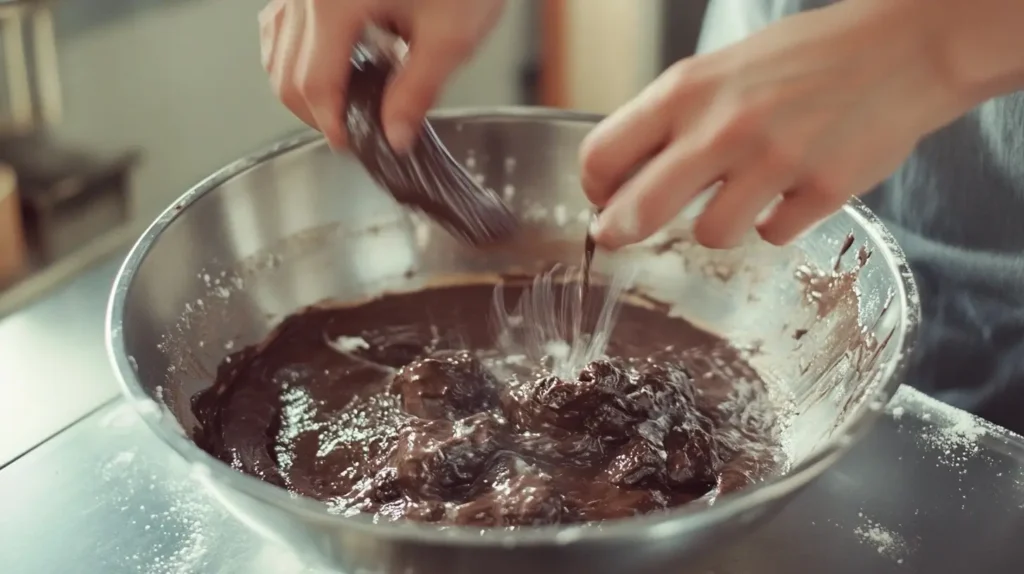
Assembling the Cobbler
Layering Techniques
Begin by pouring the prepared batter into a greased baking dish, spreading it evenly with a spatula. The key here is to create a uniform base, as this ensures even cooking and a consistent texture throughout the dessert.
Adding Toppings
Next, sprinkle a generous layer of granulated sugar, brown sugar, and cocoa powder evenly over the batter. This topping will work its magic during baking, creating a luscious chocolate sauce that sinks to the bottom while leaving a crusty, sugary layer on top.
Importance of Boiling Water in the Recipe
Here’s the secret to chocolate cobbler: boiling water. Carefully pour hot water over the top without stirring. This step might seem unusual, but as the cobbler bakes, the water combines with the sugar and cocoa to form the gooey chocolate sauce beneath the crust. Be gentle when pouring to preserve the layered effect.
Baking Process
Optimal Oven Temperature
Preheat your oven to 350°F (175°C) for the best results. This temperature allows the cobbler to cook evenly, ensuring the topping becomes golden and cake-like while the chocolate sauce thickens underneath. Using an oven thermometer is a good idea to verify the temperature, as some ovens run slightly hot or cold.
Determining Doneness
Bake the chocolate cobbler for approximately 35–40 minutes. You’ll know it’s ready when the top looks set and slightly puffed, with a light, crackly texture. The edges should pull away from the sides of the baking dish, but the center will still jiggle slightly due to the gooey sauce underneath. To avoid overbaking, resist the urge to leave it in the oven until fully firm—this could dry out the sauce.
Cooling Time Recommendations
Allow the cobbler to cool for about 10–15 minutes after removing it from the oven. This resting period helps the sauce thicken slightly while the flavors meld together. Don’t rush this step, as serving it too soon might make the dessert overly runny. However, don’t wait too long—it’s best enjoyed warm, perhaps with a scoop of ice cream or a dollop of whipped cream for contrast.
Ideal Pairings for Easy Chocolate Cobbler
Ice Cream Flavors That Complement Fudgy Chocolate Cobbler
A warm fudgy chocolate cobbler becomes irresistible when paired with a scoop of ice cream. Classic vanilla is a timeless choice, offering a creamy and mildly sweet contrast to the rich chocolate sauce. For adventurous palates, salted caramel or coffee ice cream adds a sophisticated twist. If you prefer fruity flavors, strawberry or raspberry ice cream provides a refreshing tang that balances the dessert’s intensity.
Whipped Cream Variations for Homemade Chocolate Cobbler
Whipped cream adds an airy, luscious layer to a dense homemade chocolate cobbler. The traditional version, made with heavy cream and sugar, is a foolproof favorite. To enhance its flavor, consider adding a splash of vanilla or almond extract. Cocoa-infused whipped cream is another delightful option, complementing the chocolate without overpowering it. This pairing ensures a luxurious finish for your dessert.
Fresh Fruit Complements for Southern Chocolate Cobbler
Brighten the richness of Southern chocolate cobbler by pairing it with fresh fruit. Sliced strawberries, raspberries, or banana slices bring a natural sweetness and tang that contrast beautifully with the chocolate. Scatter the fruit around the plate or atop the cobbler for a vibrant and healthy addition. Not only does this elevate the flavor, but it also adds a colorful visual appeal.
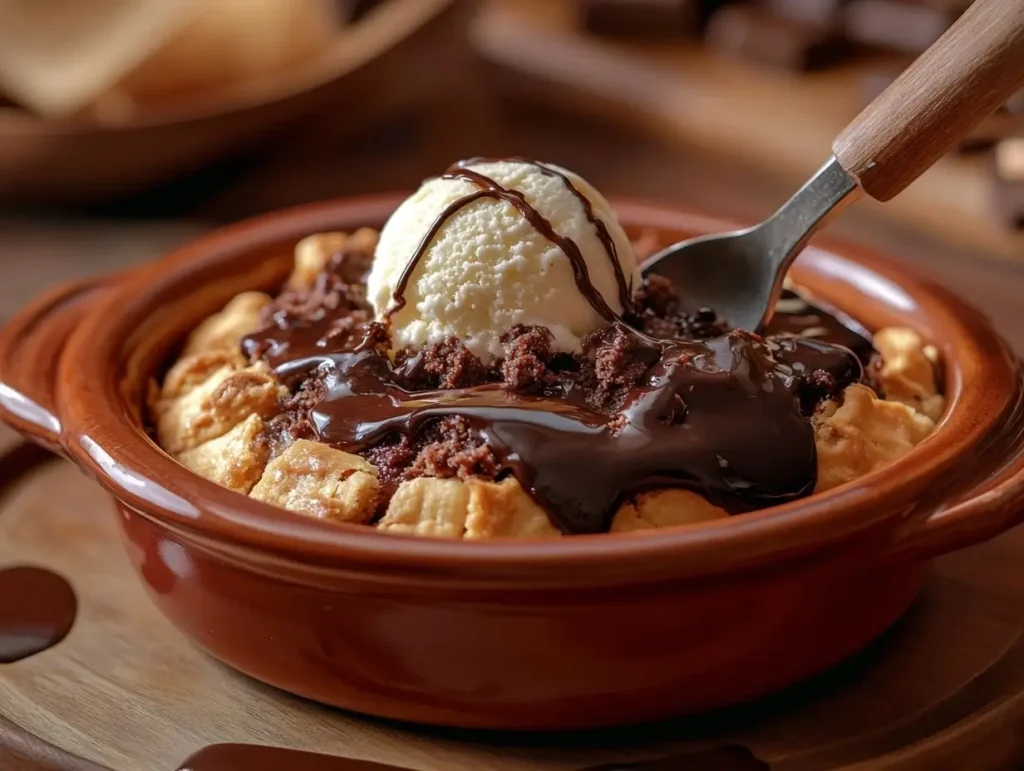
Presentation Tips for Chocolate Dessert Recipes
Plating Techniques for Chocolate Cobbler
Serve your chocolate cobbler in shallow dessert bowls or individual ramekins for an elegant presentation. Position the cobbler slightly off-center to leave room for a scoop of ice cream or a dollop of whipped cream. Using pastel or white dishware creates a striking contrast with the dark chocolate, making the dessert visually enticing.
Garnishing Ideas for Easy Chocolate Cobbler
Add a professional touch by dusting powdered sugar or cocoa powder lightly over the cobbler. Garnish with a fresh mint leaf for a pop of green, or drizzle chocolate syrup artistically on the plate for added flair. For special occasions, edible gold flakes or colorful sugar crystals can add a festive sparkle to this beloved dessert.
Flavor Variations for Homemade Chocolate Cobbler
Adding Nuts to Easy Chocolate Cobbler
Incorporating nuts into your chocolate cobbler adds a delightful crunch and elevates both texture and flavor. Pecans and walnuts are traditional favorites, offering a sweet, buttery complement to the rich chocolate base. Simply sprinkle chopped nuts on top of the batter before baking, or mix them into the topping for a nutty surprise in every bite. For a more adventurous twist, try using hazelnuts or almonds, which pair beautifully with chocolate’s deep flavors.
Incorporating Fruits in Fudgy Chocolate Cobbler Recipes
Fruit can provide a tangy contrast to the sweetness of fudgy chocolate cobbler. Cherries and raspberries are classic additions, enhancing the dessert’s richness with a burst of natural acidity. For a fun variation, layer sliced bananas over the batter before adding the topping. Tropical fruits like diced pineapple or mango can also add a unique flair, making the cobbler both flavorful and visually appealing.
Using Different Chocolates in Southern Chocolate Cobbler
Experimenting with various chocolate types can completely transform the flavor profile of your Southern chocolate cobbler. Dark or bittersweet chocolate offers a bold, less sugary taste for those who prefer a more intense dessert. Milk chocolate, on the other hand, provides a creamy and sweet balance, making the cobbler extra indulgent. White chocolate is another fun option—just adjust the sugar levels in the recipe to prevent it from becoming overly sweet. Adding a handful of mixed chocolate chips to the batter creates gooey pockets of melted chocolate throughout, delighting every bite.
Dietary Modifications
Gluten-Free Alternatives
Making a gluten-free chocolate cobbler is simple with a few swaps. Replace all-purpose flour with a gluten-free baking mix, and ensure your cocoa powder and other ingredients are certified gluten-free. Keep in mind that gluten-free batters may be slightly denser, so don’t skip the sifting step to incorporate air.
Vegan Substitutions
For a vegan version, use plant-based milk like almond or oat milk instead of dairy milk. Swap butter for vegan margarine or coconut oil, and ensure your sugar is vegan-friendly (some are processed with bone char). Add a teaspoon of apple cider vinegar to the wet ingredients to mimic the tenderness of a traditional recipe.
Reducing Sugar Content
If you’re looking to cut back on sugar, reduce the amount of granulated and brown sugar in the recipe. Natural sweeteners like maple syrup or coconut sugar can serve as healthier substitutes while maintaining a caramelized flavor. You can also use unsweetened cocoa powder and opt for a darker chocolate to further minimize added sugars. For tips on using natural sweeteners like maple syrup or coconut sugar, check out this guide to healthier sugar substitutes.
Addressing Common Baking Problems in Chocolate Dessert Recipes
Preventing a Soggy Bottom in Easy Chocolate Cobbler
A soggy bottom is a frequent issue with fudgy chocolate cobbler, especially when the sauce layer doesn’t set as intended. To avoid this problem, ensure you’re using the correct baking dish size. If the dish is too small, the layers won’t bake evenly. Always preheat your oven to 350°F (175°C), as this ensures even cooking from the start. Additionally, avoid adding excessive liquids to the batter or undermeasuring the dry ingredients, as this can disrupt the delicate balance of the recipe. If you notice extra moisture during baking, extend the bake time by a few minutes to firm up the base without drying out the top.
Achieving the Desired Consistency in Homemade Chocolate Cobbler
The ideal texture for a Southern chocolate cobbler combines a fluffy, slightly crisp top with a rich, gooey base. Overmixing the batter can lead to a dense topping, so mix just until the ingredients are combined. For the sauce, gently pour boiling water over the batter in an even layer—this step is crucial for creating the cobbler’s self-saucing effect. Avoid stirring at this stage, as it would disrupt the layers. If the topping appears dry and cracked while the sauce remains too watery, give the cobbler a few additional minutes in the oven.
Adjusting for Altitude in Fudgy Chocolate Cobbler Recipes
Altitude can impact the success of your chocolate dessert recipe. At higher elevations, reduced air pressure can cause the cobbler to rise too quickly and then collapse. To counteract this, slightly reduce the baking powder in the recipe and add an extra tablespoon of flour. Raising the oven temperature by 15°F (9°C) and reducing the bake time can also help the cobbler set before over-expansion occurs. These small adjustments ensure your dessert turns out perfectly every time.
FAQs About Making Chocolate Cobbler
What is chocolate cobbler?
Chocolate cobbler is a warm, gooey dessert that creates its own chocolate sauce during baking. It consists of a cake-like topping that forms over a rich, pudding-like chocolate layer. It’s an easy-to-make, comforting treat that’s perfect for any occasion.To dive deeper into its history and unique characteristics, visit What Is Chocolate Cobbler? A Delicious Southern Dessert Explained.
How to BBQ Right Chocolate Cobbler
Cooking a chocolate cobbler on a BBQ grill is possible! Use a cast-iron skillet or a grill-safe baking dish. Prepare the cobbler as usual and place it on the grill over indirect heat. Close the lid and cook at around 350°F (175°C) until the top is set and the sauce is bubbling.
Do you refrigerate chocolate cobbler?
Yes, you should refrigerate leftover chocolate cobbler to keep it fresh. Store it in an airtight container and reheat individual portions in the microwave or oven before serving. However, cobbler is best enjoyed fresh and warm.
How to make chocolate pecan cobbler?
To make a chocolate pecan cobbler, add a generous layer of chopped pecans over the batter before sprinkling the sugar and cocoa topping. This adds a delightful crunch and a nutty flavor that pairs beautifully with the chocolate.
Is cobbler supposed to be moist?
Yes, cobbler should be moist. The bottom layer should be gooey and saucy, while the topping remains soft and slightly crisp. If it’s too dry, it may have been overbaked or lacked sufficient liquid in the batter.or a detailed guide on achieving the perfect texture, check out Is Cobbler Supposed to Be Moist? A Comprehensive Guide to Perfect Cobbler.
What’s the difference between a peach cobbler and a crumble?
The key difference is in the topping. A peach cobbler has a biscuit or cake-like topping, while a crumble uses a streusel-like topping made with butter, sugar, and sometimes oats for a crumbly texture. For a detailed explanation of all key differences, visit Peach Cobbler vs Crumble: Key Differences Explained.
What is cobbler crust made of?
Cobbler crust typically consists of a batter or dough made from flour, sugar, butter, and milk. The texture is softer and more cake-like compared to pie crusts.
Why is my cobbler so runny?
A runny cobbler can result from underbaking or using too much liquid in the batter. Ensure the cobbler is baked until the top is fully set and the sauce has thickened. Allowing it to cool slightly before serving also helps the sauce firm up.
Can I use a different type of flour?
Absolutely! While all-purpose flour is the standard, you can use gluten-free flour blends for a gluten-free version. Whole wheat flour can add a heartier texture, though it may make the cobbler denser. Adjust liquids slightly if the flour absorbs more moisture.
Conclusion
Making a chocolate cobbler at home is not only simple but also a deeply satisfying experience. This beloved dessert, with its gooey chocolate sauce and soft, cake-like topping, offers a comforting indulgence that’s perfect for any occasion. By carefully selecting the right ingredients, following the step-by-step process, and exploring flavor variations, you can create a cobbler that’s tailored to your taste and dietary needs.
Whether you pair it with ice cream, whipped cream, or fresh fruit, or enjoy it as is, this dessert is sure to impress family and friends. And now that you’ve mastered the basics, you can experiment with creative twists like adding nuts or trying different types of chocolate to keep your cobbler repertoire exciting.
With its nostalgic charm and rich flavors, chocolate cobbler is more than just a dessert—it’s a treat that brings people together. So preheat your oven, grab your favorite baking dish, and enjoy the magic of creating this decadent masterpiece from scratch. Bon appétit!
